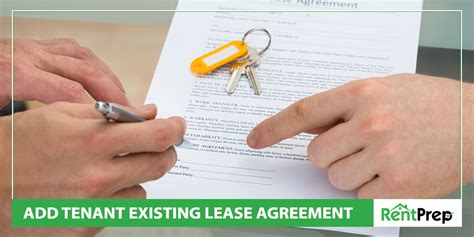The Landlord's Perspective: Adding Tenants to the Lease
Adding tenants to an existing lease agreement is a common scenario for landlords, but it’s a process that requires careful consideration and adherence to legal guidelines. This article will explore the landlord's perspective on this process, addressing common questions and concerns. We'll cover everything from the legal implications to practical advice for navigating this situation smoothly.
Why Landlords Might Add Tenants to a Lease
Several reasons might prompt a landlord to consider adding tenants to an existing lease:
- Vacant Room: An existing tenant may want to sublet a room or share their apartment to reduce costs or find a roommate.
- Increased Rent: Adding a tenant can increase the overall rental income, potentially offsetting expenses.
- Tenant Request: Existing tenants might request the addition of a new tenant, perhaps a family member or significant other.
Legal Considerations: Can I Just Add Anyone?
No. Simply adding a tenant's name to the lease without the proper procedure and consent of all parties involved is legally risky. This is where understanding your local tenant laws is crucial. Failure to follow these regulations can lead to legal disputes and financial penalties.
What are the legal implications of adding a tenant to an existing lease?
The legal implications vary by jurisdiction, but generally, adding a tenant requires written consent from all parties—the landlord and all existing tenants. This usually involves creating an addendum to the original lease agreement, outlining the terms for the new tenant, including responsibilities, rent share, and duration of occupancy. This ensures that everyone understands their rights and responsibilities. Failure to obtain this consent could be interpreted as a breach of contract.
How to Properly Add a Tenant to a Lease
The process generally involves these steps:
- Tenant Application and Screening: Even if the existing tenant vouches for the new tenant, it's crucial to perform a thorough screening process. This includes credit checks, background checks, and verification of employment and income.
- Addendum to the Lease: Prepare a formal addendum to the original lease agreement, specifically outlining the terms for the new tenant. This should include:
- Name and contact information of the new tenant.
- The new tenant's share of the rent and other utilities.
- The new tenant's responsibilities regarding the property.
- The start and end date of the new tenant's occupancy.
- Consequences of breaching the agreement.
- Signatures from All Parties: Ensure that all parties—the landlord, existing tenants, and the new tenant—sign and date the addendum. Keep a copy for your records.
- Updated Rent Payment Arrangement: Establish a clear process for rent collection, whether it's a single payment or separate payments from each tenant.
- Notification of Change: Notify your insurance provider about the change in occupancy, as this could affect your coverage.
What if a Tenant Wants to Sublet Without My Permission?
Subletting is a different scenario. Many leases prohibit subletting without the landlord's written consent. If a tenant sublets without permission, it's a breach of the lease agreement, and you have grounds to take legal action. The consequences could include eviction of both the original and the subletting tenant. Always consult with your legal counsel in these situations.
What Happens if a New Tenant Doesn't Pay Rent?
If a newly added tenant fails to pay their share of the rent, you should follow the same eviction process as you would for any other non-paying tenant. However, it's important to have clear documentation of the addendum and the payment arrangements.
What about Insurance and Liability?
Adding tenants may affect your landlord insurance policy. It's essential to inform your insurance provider about the change in occupancy to ensure adequate coverage. Review your policy and consult your insurer to understand any implications.
Conclusion
Adding tenants to a lease is a significant step that requires careful planning and adherence to legal regulations. By following the outlined procedures, landlords can protect their interests while maintaining positive tenant relationships. Remember to consult with a legal professional to ensure you comply with all relevant laws in your jurisdiction. The information provided in this article is for general guidance only and does not constitute legal advice.

